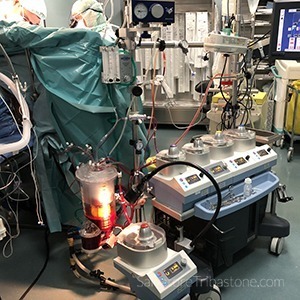The heart-lung machine is a biomedical device that allows the survival of the patient when the heart and lungs are stopped to intervene surgically on the cardiac structures during cardiac surgery. In this way the cardiac and pulmonary functions are guaranteed by this machine which is used for the cardiopulmonary bypass (CPB).
For its normal operation and management during cardiac surgery, it’s necessary the presence of specialized personnel, the cardiopulmonary bypass technician (perfusionist), who takes care, following the instructions of the cardiac surgeon, to start the CPB, to conduct it in the various phases of the intervention and to stop it when the cardiac surgeon completes the heart surgery.
 The cardiopulmonary bypass mechanism involves a first phase, managed by the cardiac surgeon, of cannulation of the venae cavae (superior and inferior) and of the ascending aorta by positioning cannulas of polymeric material (PVC) that are connected to the CPB circuit after the heparinization of the patient to avoid thrombus formation inside the circuits and oxygenator.
The cardiopulmonary bypass mechanism involves a first phase, managed by the cardiac surgeon, of cannulation of the venae cavae (superior and inferior) and of the ascending aorta by positioning cannulas of polymeric material (PVC) that are connected to the CPB circuit after the heparinization of the patient to avoid thrombus formation inside the circuits and oxygenator.
Schematically the venous (non-oxygenated) blood of the patient is ‘taken’ from the cannulas placed in the right atrium (monocannulation) or in the superior and inferior venae cavae (double cannulation) and is sent to the oxygenator which has the function of the lung, ie that of oxygenation of the venous blood to make it available as arterial (oxygenated) blood and push it through a centrifugal pump or roller pump through the arterial cannula into all the patient’s organs for the duration of the cardiac surgery. The exclusion of the heart and lungs occurs as soon as a clamp closes the ascending aorta, initiating the cardiopulmonary bypass.
At this point you have to stop the heart to allow access to the cardiac cavities using a cardioplegic solution (crystalloid or hyperpotassic blood) which injected into the aortic bulb or directly into the coronary arteries determines the stop of the cardiac activity.
During heart surgery, the blood of the cavities is recovered through aspirators that are part of the heart-lung machine and introduced after appropriate filtration in the oxygenating system.
A heater–cooler device connected to the oxygenator allows the cooling of the patient to the required body temperature and to subsequent heating up to normothermia when the cardiac surgeon completes the surgery.
Reopening the aortic cross clamp usually allows the heart to spontaneously restart or after some electric shock. At this stage the heart begins to beat after surgical correction and the cardiopulmonary bypass is gradually reduced to the stop.
The ‘natural’ blood flow and oxygenation is now restored through the patient’s heart and lungs.

